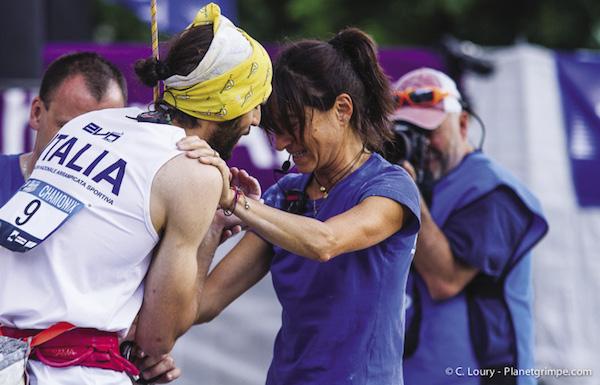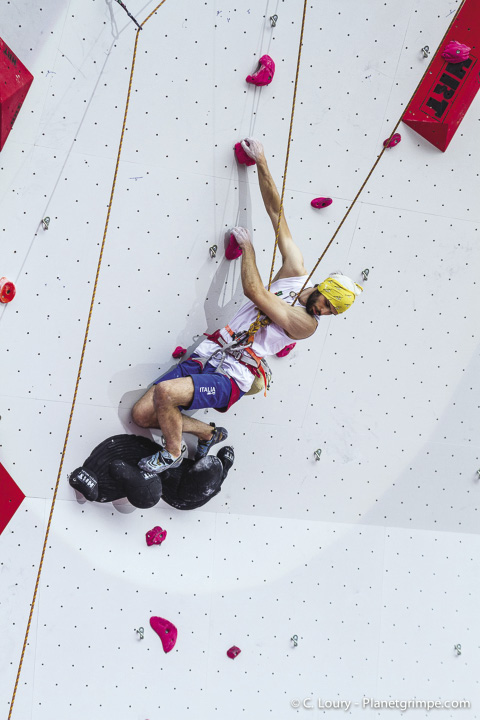There is a moment of particular suspension in the climb that should be tried at least once. As if in life, in that moment of emptiness that lies between a passage and the other, one enters into a more authentic dimension. The feel of the rock, embracing the mountain with one’s own body, and knowing how this embrace can become dangerous, the challenge with one’s own limits. We rise from the abyss of everyday life to reach the top. Then, once we get up there, at the top, we can only go down, stronger and happier, ready to go back up again. To challenge yourself climbing mountains takes on an even greater value when one is blind like Matteo Stefani. Twenty-two years old, world champion in paraclimbing in the Lead and Speed disciplines and winner of international and European championships, Matteo is certainly not afraid to surpass his own limits. Hanging from a rock, he has succeeded in reaching his dreams and transforming a limitation into an advantage.
One who does not see has a way to know and perceive the world through the other senses. This modality is very useful in a sport like climbing where the physical contact with the wall and space is complete. Touch, instinct, concentration and a lot of ability to imagine a world without borders. To begin, let’s ask Matteo where and how this sport is performed. “Sport climbing, unlike its sister alpine or mountain climbing, takes place on rock walls of varying heights usually up to 30 metres, or on man-made structures that simulate rock and reach heights up to 20 metres. The aim is not to reach the top of a mountain, as in the case of mountain climbing, but to be able to climb up on walls whose holds increase in difficulty according to size, type and distance. In so doing, security is of paramount importance. Though both disciplines require that the climber wear a harness which is attached to a safety line managed by a climbing partner who is not himself climbing, in sport climbing, the metal rings on which the rope is fixed with hooks are at close range and secured, while in mountain climbing their distance may be greater and varied and they may be attached in a more precarious way.”
How can a person with vision loss do this?
“The person can climb almost completely in an independent manner on walls of low difficulty where footholds can easily be found by feeling around with their hands. On more difficult walls, however, it is necessary to be given directions from a person at the bottom of the wall. To facilitate communication, it is best to use special radio equipment with a microphone and earpiece. The visually impaired climber needs to climb up several times to learn the features of the wall by heart in order to climb independently. Sometimes people with their sight can even perform workouts blindfolded. In fact, when you don’t see the holds to grip, this forces you to pay more attention to the position of your body in order to make the least effort to reach the hooks.”
How did you start climbing?
“I was about eleven years old. I was in the mountains with my family, and my dad took me and my sister to try to climb on a rock at the edge of a path. Surprisingly, I felt immediately at ease with this new dimension, I could easily move on all fours on the rocky surface following the directions I was given and feeling around with my hands. So, whenever we would go hiking in the mountains, I always insisted that we find a cliff where I could climb. And then, when I went to high school, I was able to attend an afternoon climbing workshop at Bologna’s CUSB gym. Then I met Carla Galletti who became my coach and the coach of two other kids with visual impairment, Giulia Poggioli and Julius Cevenini. Together we form a really good team. Today, Carla trains us with Federico Stella, our athletic trainer, and Pietro Dal Prà, a world-famous climber. They are our guides when we climb. With them we share goals and a desire to raise awareness about the sport so that other people with vision loss get to practise it and so that through our testimony spread more and more a culture of inclusion of people with disabilities. On Pietro’s initiative, we organized the first national day of climbing for the blind in ten different climbing gyms in Italy on February 21st, the day which commemorates Louis Braille. Our team experience was also told in the documentary film Vincersi by Mirko Giorgi and Alessandro Dardani.”

With their commitment Matteo and his team also climb the walls of prejudice. Is climbing also a way to broaden horizons and have new perspectives?
“Yes, it has allowed me to express myself fully and in various ways at the physical level despite my visual disability, even if for a person who does not see it’s always more difficult, the pleasure and the results I get have led me to commit myself even more to this activity. I want to emphasize that whether the person is sighted or blind they will use the same climbing techniques, and this allows for a good exchange of views and experiences among all climbers.”
Beyond the competition itself, is the mountain also for you the place for inner peace?
“Nature in general and mountains in particular give me much joy and serenity. Mostly though, I would call it a place of growth where I can experience what it means to manage my emotions, stay focused and committed to overcome difficulties even if I’m tired and trying to spend as little energy as possible. Surely the motivation that this sport gives me to grow both mentally and physically has so far been so strong and I think it will be the same as I go forward.”




.png)